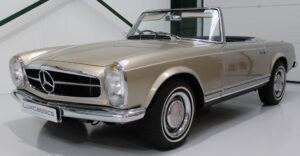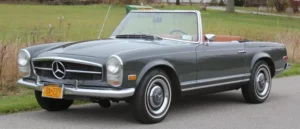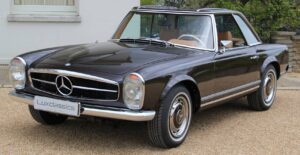Mercedes W113: The evolution of the iconic Pagoda
1. The evolution of the Mercedes-Benz W113: From 250SL to 280SL
2. The California roadster: A unique variant
3. Refinements and federal regulations
5. Adapting to stricter regulations
The evolution of the Mercedes-Benz W113: From 250SL to 280SL
Opening on March 9th, the 1967 Geneva Motor Show served as the ideal venue for the public debut of the Mercedes-Benz 250SL. While the differences between the 2.3-liter 230SL and the new 2.5-liter model were subtle, the most notable upgrades lay beneath the hood.
One of the key improvements was the transition from the M127 engine, which had only four main bearings, to the M129.982 six-cylinder engine. This new power unit, borrowed almost directly from the 1967 W108 250SE saloon, featured a seven-bearing bottom-end, providing greater refinement. Although the bore remained at 82mm, an increased stroke of 78.8mm boosted the displacement to 2496cc. With an updated cylinder head featuring new valves and ports, along with a raised compression ratio of 9.5:1, the official power output remained unchanged, but torque was improved by a valuable 10%.
The 250SL retained the same three transmission options as its predecessor but adopted a taller final-drive ratio for manual models. Another notable upgrade was the braking system—now featuring disc brakes on all four wheels. In keeping with Porsche’s practice and that of other European sports car manufacturers, the rear discs incorporated small drum brakes specifically for the handbrake, balancing high-speed stopping power with effective stationary holding capability.
The California roadster: A unique variant
An interesting variation of the 250SL was the California Roadster. This model eliminated the soft-top and its metal cover, replacing them with a rear bench seat. While this setup allowed short journeys with additional passengers, it primarily served as a practical luggage shelf when folded. However, as the soft-top could not be retrofitted, this variant was best suited for regions with minimal rainfall—such as the U.S. state that inspired its name.
Refinements and federal regulations
Most early 250SL press cars retained the dashboard and door trim from the 230SL, but minor modifications were introduced in July 1967 in preparation for 1968 U.S. federal regulations. These included redesigned switchgear and door trim to enhance safety in the event of an accident. Three-point seatbelt mounts, a new energy-absorbing steering column (recognizable by its revised center boss and horn ring), and foam padding on the windshield frame were also added. Additionally, American-spec models featured side repeater indicators on the front and rear wings, making them easily identifiable.
Despite its advancements, the 250SL had a short production run, ending in January 1968 when the 280SL was introduced. With only 5,196 units built, the 250SL remains a rare and desirable model. Externally, the only major distinguishing feature from the 230SL was the badge on the tail, while all W113 variants featured a soft-top that folded beneath a concealed panel similar to that of the 300SL Roadster.
The arrival of the 280SL
At the beginning of 1968, Mercedes-Benz upgraded the 250SL to the 280SL, just as it had done with the 250SE and 280SE in the W108 lineup. The new model featured the M130 engine with a hotter camshaft, boosting output by 10bhp to a total of 170bhp DIN at a higher rpm. Torque also increased to 177 lb-ft, enhancing overall drivability. The 280SL retained the same transmission options—four-speed manual (4MT), five-speed manual (5MT), and four-speed automatic (4AT)—while chassis components remained largely unchanged, aside from improved rubber bushings that extended service intervals and slight modifications to tire construction.
While the badge on the rear was the primary way to differentiate a 280SL from earlier models, wheel trims provided another clue. The 280SL introduced a one-piece wheel cover, replacing the previous two-piece design that had left part of the body-colored wheel exposed. From 1969, alloy wheels (6J x 14) became available as a dealer option and were later offered as a factory-installed option from August 1970.
Adapting to stricter regulations
By the late 1960s, increasingly stringent U.S. safety and emissions regulations forced further modifications. The 280SL introduced a fuel shut-off valve that engaged during low-speed deceleration, a viscous-coupled thermostatically controlled cooling fan, and a revised camshaft with different valve timing. These changes resulted in an 8% power reduction, but compliance with U.S. laws was essential for maintaining access to the world’s largest market for European sports cars. To compensate, early U.S. models featured a shorter rear axle ratio, though this was standardized by the end of 1969.
The end of the Pagoda era
Production of the 280SL ended in March 1971, marking the conclusion of the iconic ‘Pagoda’ roof generation. With 23,885 units built, the 280SL contributed to a total W113 production run of 48,912 cars. Despite its immense popularity, the W113 series ultimately faced increasing pressure from evolving safety standards and changing automotive design trends. By this time, the styling of the Pagoda SL had begun to look dated next to modern Mercedes models like the C111 concept car.
While the W113 generation remains a beloved classic, its successor would go on to achieve even greater commercial success, cementing the SL’s legacy as one of the most enduring nameplates in automotive history.
Are you already a proud owner of a Mercedes W113 and Mercedes W123? If so, check out our selection of parts for this car at the following link:
https://octoclassic.com/product-category/mercedes-benz/w123
Photos sources: MOTOR1, classic.com, luxclassics.com, classic-trader.com










